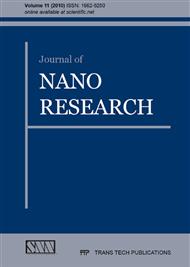p.35
p.39
p.45
p.57
p.67
p.73
p.79
p.85
p.89
Preparation of Porous Biphasic Calcium Phosphate-Gelatin Nanocomposite for Bone Tissue Engineering
Abstract:
A new porous structure as a bone tissue engineering scaffold was developed by a freeze-drying method. The porous nanocomposite was prepared from Biphasic Calcium Phosphate (BCP) which was a mixture of 70% hydroxy apatite and 30%ß-TCP (ß-Tricalcium Phosphate). Porogen was naphthalene and gelatin from bovine skin type B was used as polymer. Gelatin was stabilized with EDC (N-(3-dimethyl aminopropyl)-N´-ethyl carbodiimide hydrochloride) by a cross-linking method. The scaffold was characterized by scanning electronic microscope (SEM), Fourier-Transformed Infrared spectroscopy (FTIR). The biocompatibility of this nanocomposite carried out through MTT (3-(4, 5-Dimethylthiazol-2-yl)-2, 5-diphenyltetrazolium bromide, a tetrazole) cell viability assay. Also other properties of scaffold such as morphology, grain size, bending strength were investigated. Highly porous structure with interconnected porosities, good mechanical behavior and high biocompatibility with bone tissue, were benefits of this porous nanocomposite for bone tissue engineering.
Info:
Periodical:
Pages:
67-72
Citation:
Online since:
May 2010
Keywords:
Price:
Сopyright:
© 2010 Trans Tech Publications Ltd. All Rights Reserved
Share:
Citation:


